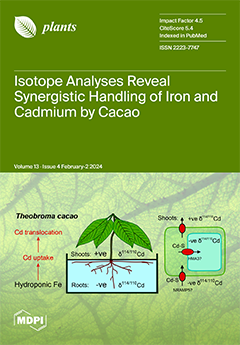When plants are exposed to salt stress, endogenous hormones are essential for their responses through biosynthesis and signal transduction pathways. However, the roles of endogenous hormones in two cliff species (
Opisthopappus taihangensis and
Opisthopappus longilobus (
Opisthopappus genus)) in the Taihang Mountains under salt stress have not been investigated to date. Following different time treatments under 500 mM salt concentrations, 239 differentially expressed gene (DEG)-related endogenous hormones were identified that exhibited four change trends, which in Profile 47 were upregulated in both species. The C-DEG genes of AUX, GA, JA, BR, ETH, and ABA endogenous hormones were significantly enriched in
Opisthopappus taihangensis (
O. taihangensis) and
Opisthopappus longilobus (
O. longilobus). During the responsive process, mainly AUX, GA, and JA biosynthesis and signal transduction were triggered in the two species. Subsequently, crosstalk further influenced BR, EHT, ABA, and MAPK signal transduction pathways to improve the salt resistance of the two species. Within the protein–protein interactions (PPI), seven proteins exhibited the highest interactions, which primarily involved two downregulated genes (
SAUR and
GA3ox) and eight upregulated genes (
ACX,
MFP2,
JAZ,
BRI1,
BAK1,
ETR,
EIN2, and
SNRK2) of the above pathways. The more upregulated expression of
ZEP (in the ABA biosynthesis pathway),
DELLA (in the GA signaling pathway),
ABF (in the ABA signaling pathway), and
ERF1 (in the ETH signaling pathway) in
O. taihangensis revealed that it had a relatively higher salt resistance than
O. longilobus. This revealed that the responsive patterns to salt stress between the two species had both similarities and differences. The results of this investigation shed light on the potential adaptive mechanisms of
O. taihangensis and
O. longilobus under cliff environments, while laying a foundation for the study of other cliff species in the Taihang Mountains.
Full article






